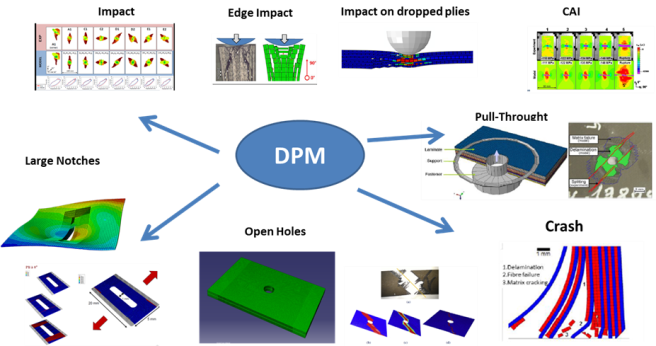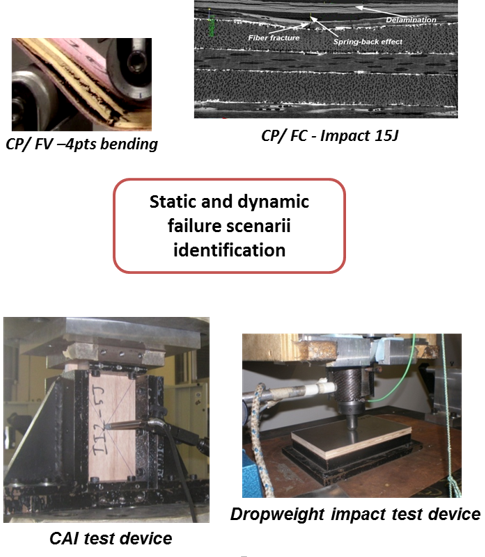STRUCTURES AND MODELLING STRATEGIES
1. Short fibers
This is the development and validation of solutions for injected polymer materials, with their properties induced by the injection process. A behaviour law with damage (CDM) is proposed, which takes the microstructural parameters related to the process into account and is “implementable” in an industrial finite element code. Its applications are dedicated to the dimensioning of composite parts injected with PEEK thermoplastic matrices reinforced with short carbon fibres, e.g., the calculation of a helicopter door hinge. The ICA has also been working on the injection of PEEK resin loaded with carbon fibres within industrial projects and / or PhD theses. Some results of these projects are already in use.
As an extension of these studies, work is underway concerning the recycling of carbon fibres so as to re-use them in various forms (mats, short fibre granules) within thermoplastic matrices. This work contributes to the setting up of an industrial recycling sector in the Occitanie Region.

2. Modelling Strategies
[C. Bouvet, B. Castanié, O. Dorival , JF. Ferrero, F. Lachaud, S. Marguet, L. Michel, P. Navarro, S. Rivallant]
For the past twenty years, ICA professors have specially focused their research on the development of strategies for modelling damage and fracture scenarios of composite structures. Three main strategies have been developed.
The first is the DDM (for Diffuse Damage Model). It combines Continuum Damage mechanics laws for mechanical damage with cohesive zones. Because of the general nature of implementable laws, the DDM can be applied to many classical materials and problems, such as impact for example. Recently it has been used for sizing junctions in CFRP or SiC-SiC. It is also interesting for bearing issues.
The second is the DPM (for Discrete Ply Model). It is based on a mesh that follows the orientations of the unidirectional plies, on cohesive zones, on a fragile rupture in matrix cracking driven by the adjacent volume elements and on a fibre break taking strain energy release rates into account. It has the advantage of being based on only 13 mechanical parameters, which can be obtained easily. It has been successfully applied first to out-of-plane problems such as low velocity / low energy impact, edge impact, compression after impact or pull-through. Developed initially for out-of-plane problems, the discrete character of the model has proved to be relevant for modelling splitting and thus makes it possible to deal with problems such as hole failure, scale effects and large cuts under complex stress.

The third strategy is semi-continuous modelling used in the problems of frontal or razing impacts on helicopter blades. Bars are used to model the fibres and volumes (for the solid glass/epoxy UD) or plates (for woven plies) to model the resin. Specific elements are developed (i) to find the static characteristics and (ii) to model the damage observed at the scale of the strands. Specific cohesive elements have recently been developed, as have approaches for recovering the bending stiffness of a fabric considering the actual weaving geometry. These models have reached a high level of confidence and are now validated for certification purposes.

In general, these modelling strategies and other, more specific ones have been developed and used to respond to many application problems covering the whole field of composite structures:
- – Impact and residual behaviour after impact. Damage tolerance. Large cuts. Shields;
- – Crash: modelling, energy absorption mechanisms;
- – Fatigue;
- – Sandwich structures: nonlinear analysis, impact, inserts, modelling of foam or honeycomb cores;
- – Junctions, Z-Pinning, Stitching, Bonding;
- – Structural details: unfolding, stiffener debonding, post buckling;
- – Repairs;
- – Machining;
- – Optimization of composite structures
3. Cork and Wood-based eco-structures
[C. Bouvet, B. Castanié, F. Eyma, S. Rivallant, R. Zitoune]
An emerging theme in the group is the study of eco-conscious sandwich structures such as wood, flax-cork and jute-cork. Sandwiches with birch / poplar / okoume plywood cores and aluminium, fiberglass, flax or carbon skins have been manufactured and studied experimentally and/or numerically under static loading, impact and compression after impact. These structures have demonstrated very interesting specific and economic characteristics and studies will now focus on assembly and crash issues.

